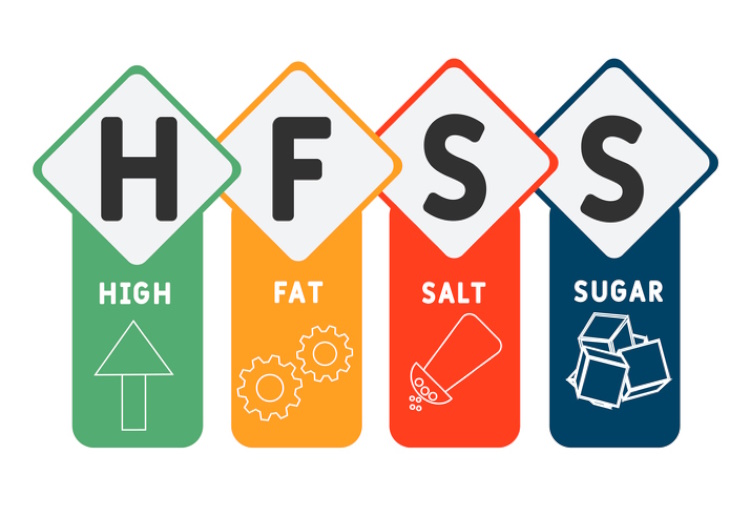
The UK is set to tighten rules on the promotion of HFSS in October 2025, a major move as part of its plan to tackle childhood obesity and improve public health. The UK will introduce a ban on TV and online advertising, fundamentally changing the way these products are advertised to consumers, particularly younger people.
What is the HFSS threshold?
The new regulations will come into force on January 1, 2019.Before 9 p.m., television advertisements for HFSS food and beverage products (obtaining a score of at least 4 points; or 1 point respectively) are prohibited.
The aim of the measure is to limit children’s exposure to advertising for “unhealthy” foods during prime time in the early evening. The ban extends online, limiting the promotion of HFSS through paid search engine ads, social media and influencer marketing.
Indeed, the UK government believes that by limiting exposure to these adverts, it will reduce the impact of HFSS marketing on children's eating choices and habits.
Health experts support restrictions on HFSS ads
Restricting advertising of "unhealthy foods" has received widespread support, especially among children.
Health experts have repeatedly pointed out that the increase in childhood obesity is directly linked to the advertising of HFSS. This includes the World Health Organization. Marketing unhealthy foods increases the consumption of these products by children, changing their eating habits and normalizing them in their diet.
Organisations such as Cancer Research UK and the British Heart Foundation, as well as Action on Sugar, are supporting the ban. The organisations argue that the ban is crucial in the fight against diet-related diseases.
Children are spending more and more time online, which has led to an increased focus on digital advertising. The influence of targeted ads is high on YouTube, Instagram and TikTok. There are concerns about the effectiveness and the need for stricter regulation to prevent unhealthy food brands from targeting children.
What foods are classified as HFSS foods?
The Nutrient Profile Model (NPM), developed by Public Health England and the Food Standards Agency, is used to categorise foods high in fat and sugar.
The classification of high-fat and high-sugar foods is based on the accumulation of points for foods containing calories, fats, sugars and sodium. Alternatively, nutrients such as fiber, fruits and vegetables or protein are deducted from the total.
Foods and drinks that score 4 or more points, or even just 1 point, are classified as high in fat or sugar.
A snack that is high in fat and sugar but low in protein or fiber will score high, but a healthier product can offset those high scores to avoid HFSS labels.
Industry resistance
Fast food companies, particularly snack and fast food brands, have expressed concerns about the new restrictions. They cite potential negative impacts on marketing and revenue strategies. Those opposed to the bans say they fail to address the root cause of obesity, which is a lack of physical activity and education.
Chile, Canada and Mexico, among others, have implemented advertising restrictions on high-fat and high-sugar foods to children with varying levels of success. Other countries are using these measures as models. They often include warning labels, nutritional information and advertising restrictions.
Health advocates say that while advertising restrictions should be welcomed, they must also be part of a comprehensive, multifaceted strategy.
In addition to bans, other policies, such as improved food labelling and taxes on sugary drinks (an initiative that has already shown success in the UK), are essential to encourage healthier eating habits among children.
Reformulation: a delicate balance
Many producers are re-evaluating their marketing strategies to find creative ways to engage with consumers. They have also begun reformulating their products to avoid the HFSS label by gradually changing ingredients to increase nutritional value. However, this process is complicated and requires technical expertise.
Reformulating a product is a real disaster. It is true that there are additional costs.But it's a concept no producer should ignore. Help is at hand.
Inequalities and their treatment
The Obesity Alliance (OHA), which counts 88 local health groups, charities and medical organisations among its supporters, has sent an open letter to the Prime Minister urging him to make reforms to achieve healthier communities.
The OHA's proposals aim to give more power to councils in deprived areas by prioritising public health, limiting the advertising of unhealthy foods, protecting councils from commercial pressure and increasing funding for the health sector with a PS1.5 billion increase.
A recent YouGov survey found that these measures are well supported by the public. 70% of respondents support banning advertising of “unhealthy foods” near schools, and 52% support restrictions on new fast food outlets opening in the area. Despite this, only 50% of respondents believe that childhood obesity will continue to rise under current policies. This reflects scepticism about their ability to deliver meaningful change.
The government has launched a consultation to look at how it can tackle obesity. However, campaigners insist that these reforms must be fully implemented if local communities are to feel empowered. Obesity is a major financial burden, with the NHS losing £6.5 billion and the wider economy £98 billion each year. Diet-related health issues are vital to economic growth and the sustainability of the NHS.
Katharine Jenner, OHA's director of policy and advocacy, believes that UK high streets are dominated by unhealthy choices.
Every child should have access to nutritious, affordable and convenient food. She said high streets are flooded with unhealthy food and drink options, which are aggressively promoted in ways that limit choice.
Since 2016, more children and adolescents have been diagnosed with type 2 diabetes, driven by an increase in obesity. Implementing the government’s Child Health Action Plan would be a significant achievement. The first and most crucial step is to empower local areas to build healthier, more active communities.
Darrell Gale, a spokesman for the Association of Public Health Directors, agrees, saying the high prevalence of poor diet is not due to personal choices, but rather circumstances.
In reality, people do not have freedom of choice. He said people are often forced to choose less healthy alternatives due to circumstances. They are also bombarded with advertising.
We can only hope to reduce this inequality by creating healthier environments where people have easier access to what they need to live longer, healthier lives.



